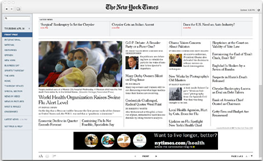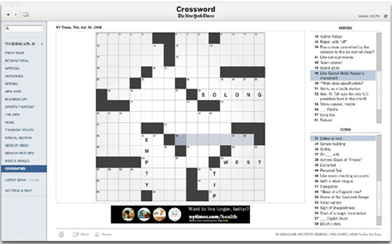 Rob Larson gives a sneak peak at New York Times Reader 2.0. The updated version of the New York Times Reader looks awesome.
Rob Larson gives a sneak peak at New York Times Reader 2.0. The updated version of the New York Times Reader looks awesome.
First, the Reader is now crossplatform. You’ll soon be able to read the New York Times on Windows, Mac and Linux. How was this accomplished? By moving the code base from Microsoft’s WPF to Adobe’s AIR platform. Whereas Microsoft only supports WPF on Windows and has a Windows and Mac version via Silverlight, there’s no Linux support.
I’ve long advocated that Microsoft should be supporting Silverlight in Linux. Having Novell or some third party to provide it is not the same.
So you say that Linux is too small of a market? Well, yes, as a classic desktop OS it is. However, look at the mobile space. There are too many Linux-based devices to be ignored. The market is still growing, but especially now while things are in flux, I wouldn’t give up anything to the competition. It’s not just the iPhone, it’s the Kindle. And on the vaporware side there’s the CrunchPad and mystical Apple tablet.
That’s not all that caught my attention with the new Reader. I’m also quite interested to see that the New York Times Reader is including their crossword puzzle now too. The Tablet PC version is no longer needed I guess.
Again, imagine this running on the Kindle DX 2. Assuming touch and ink, exactly what does this leave for Microsoft and its proprietary technology? It doesn’t matter how good the handwriting recognition is on the Tablet PC or in Windows 7, if it can’t run on a Kindle or other eReader it’s value is capped. That may be a tradeoff that Microsoft wants to make, but as a developer looking to support more content devices, I’m left scratching my head in terms of what to do. The iPhone already is a challenge. Over the years, I’ve placed successful bets–though unsure ones–on Microsoft technologies. Have I reached the end of the streak?
Think about it: Let’s say Microsoft decides to build its own eReader (or netbook) leveraging WPF or Silverlight technologies and its expertise in touch and handwriting recognition. Even if the decision were made today, we’re talking a couple years before everything could get in order.
Now if I could snap my fingers and have such a device today, that would be another thing. It would give me one good reason to stick with Microsoft technologies. However, short of that, Adobe’s approach is looking mighty attractive.


Looks like NYT dumped wpfsilverlight for Adobe AIR… http://tinyurl.com/omx6ws
This comment was originally posted on Twitter